Developing Circular Economy
VerifiedAdded on 2023/01/11
|13
|3788
|61
AI Summary
This article discusses the challenges and solutions in developing a circular economy. It explores the negative impact of single-use plastic bottles and the benefits of using reusable bottles. The article also highlights the need for education, infrastructure, and government support to promote a circular economy.
Contribute Materials
Your contribution can guide someone’s learning journey. Share your
documents today.
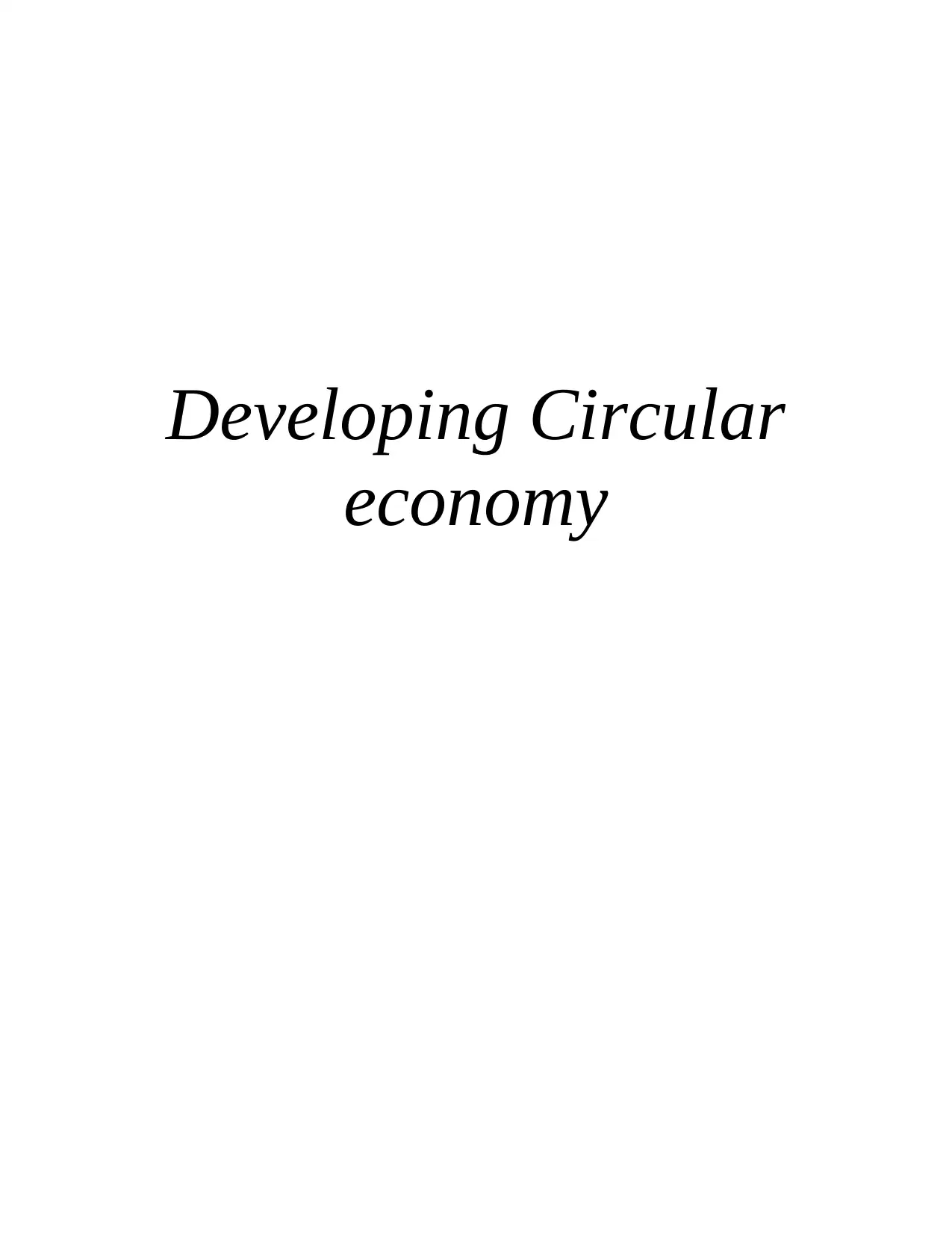
Developing Circular
economy
economy
Secure Best Marks with AI Grader
Need help grading? Try our AI Grader for instant feedback on your assignments.
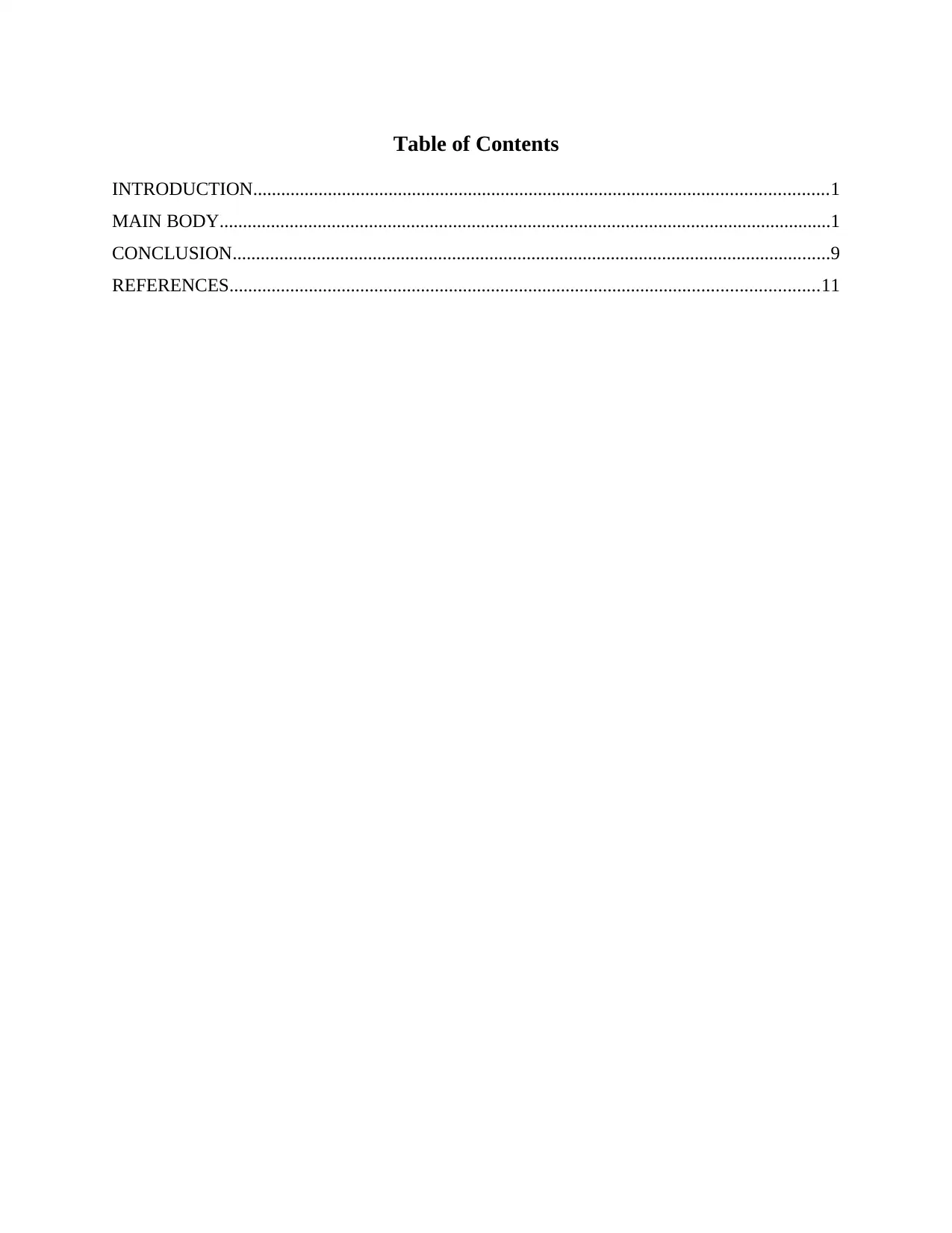
Table of Contents
INTRODUCTION...........................................................................................................................1
MAIN BODY...................................................................................................................................1
CONCLUSION................................................................................................................................9
REFERENCES..............................................................................................................................11
INTRODUCTION...........................................................................................................................1
MAIN BODY...................................................................................................................................1
CONCLUSION................................................................................................................................9
REFERENCES..............................................................................................................................11
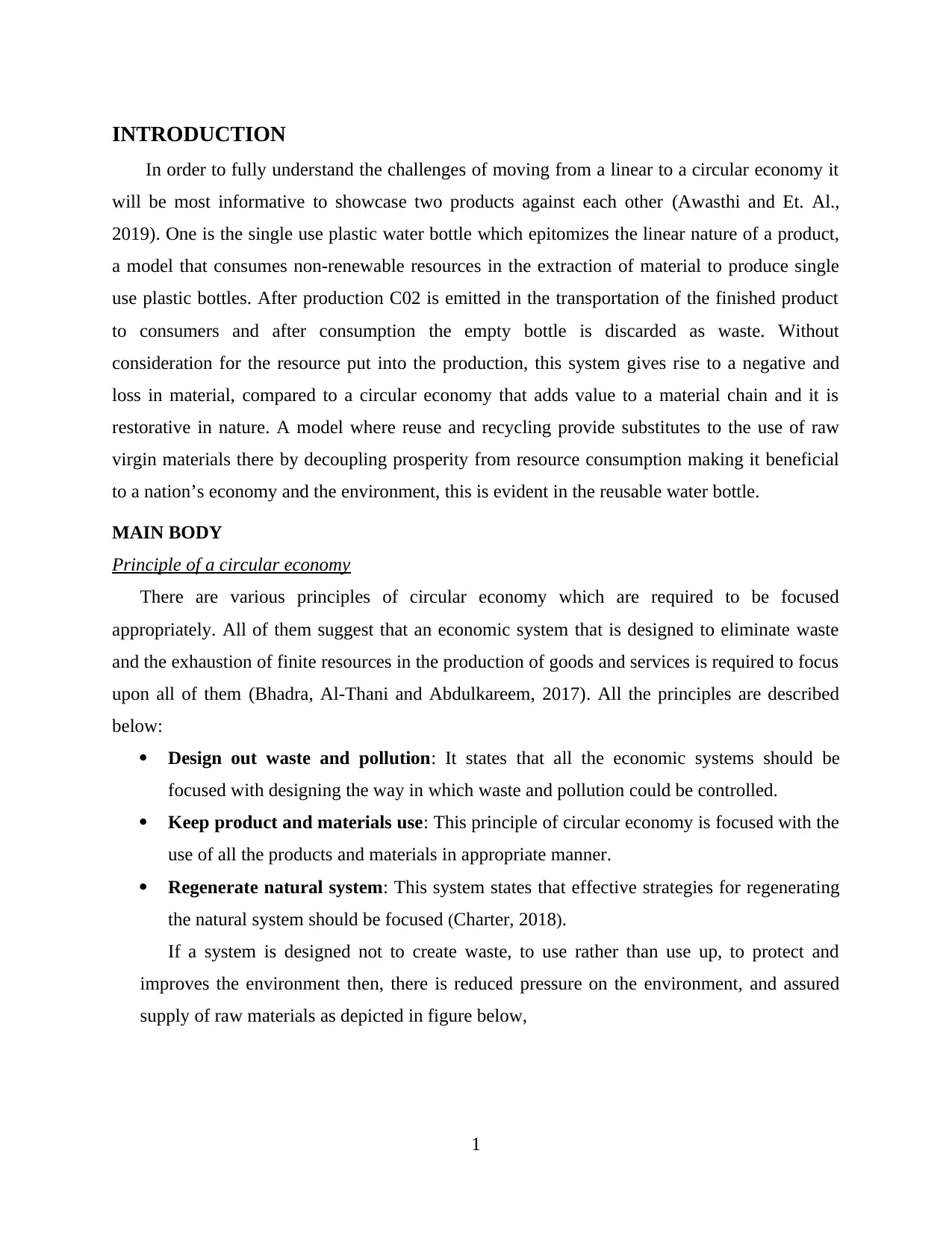
INTRODUCTION
In order to fully understand the challenges of moving from a linear to a circular economy it
will be most informative to showcase two products against each other (Awasthi and Et. Al.,
2019). One is the single use plastic water bottle which epitomizes the linear nature of a product,
a model that consumes non-renewable resources in the extraction of material to produce single
use plastic bottles. After production C02 is emitted in the transportation of the finished product
to consumers and after consumption the empty bottle is discarded as waste. Without
consideration for the resource put into the production, this system gives rise to a negative and
loss in material, compared to a circular economy that adds value to a material chain and it is
restorative in nature. A model where reuse and recycling provide substitutes to the use of raw
virgin materials there by decoupling prosperity from resource consumption making it beneficial
to a nation’s economy and the environment, this is evident in the reusable water bottle.
MAIN BODY
Principle of a circular economy
There are various principles of circular economy which are required to be focused
appropriately. All of them suggest that an economic system that is designed to eliminate waste
and the exhaustion of finite resources in the production of goods and services is required to focus
upon all of them (Bhadra, Al-Thani and Abdulkareem, 2017). All the principles are described
below:
Design out waste and pollution: It states that all the economic systems should be
focused with designing the way in which waste and pollution could be controlled.
Keep product and materials use: This principle of circular economy is focused with the
use of all the products and materials in appropriate manner.
Regenerate natural system: This system states that effective strategies for regenerating
the natural system should be focused (Charter, 2018).
If a system is designed not to create waste, to use rather than use up, to protect and
improves the environment then, there is reduced pressure on the environment, and assured
supply of raw materials as depicted in figure below,
1
In order to fully understand the challenges of moving from a linear to a circular economy it
will be most informative to showcase two products against each other (Awasthi and Et. Al.,
2019). One is the single use plastic water bottle which epitomizes the linear nature of a product,
a model that consumes non-renewable resources in the extraction of material to produce single
use plastic bottles. After production C02 is emitted in the transportation of the finished product
to consumers and after consumption the empty bottle is discarded as waste. Without
consideration for the resource put into the production, this system gives rise to a negative and
loss in material, compared to a circular economy that adds value to a material chain and it is
restorative in nature. A model where reuse and recycling provide substitutes to the use of raw
virgin materials there by decoupling prosperity from resource consumption making it beneficial
to a nation’s economy and the environment, this is evident in the reusable water bottle.
MAIN BODY
Principle of a circular economy
There are various principles of circular economy which are required to be focused
appropriately. All of them suggest that an economic system that is designed to eliminate waste
and the exhaustion of finite resources in the production of goods and services is required to focus
upon all of them (Bhadra, Al-Thani and Abdulkareem, 2017). All the principles are described
below:
Design out waste and pollution: It states that all the economic systems should be
focused with designing the way in which waste and pollution could be controlled.
Keep product and materials use: This principle of circular economy is focused with the
use of all the products and materials in appropriate manner.
Regenerate natural system: This system states that effective strategies for regenerating
the natural system should be focused (Charter, 2018).
If a system is designed not to create waste, to use rather than use up, to protect and
improves the environment then, there is reduced pressure on the environment, and assured
supply of raw materials as depicted in figure below,
1
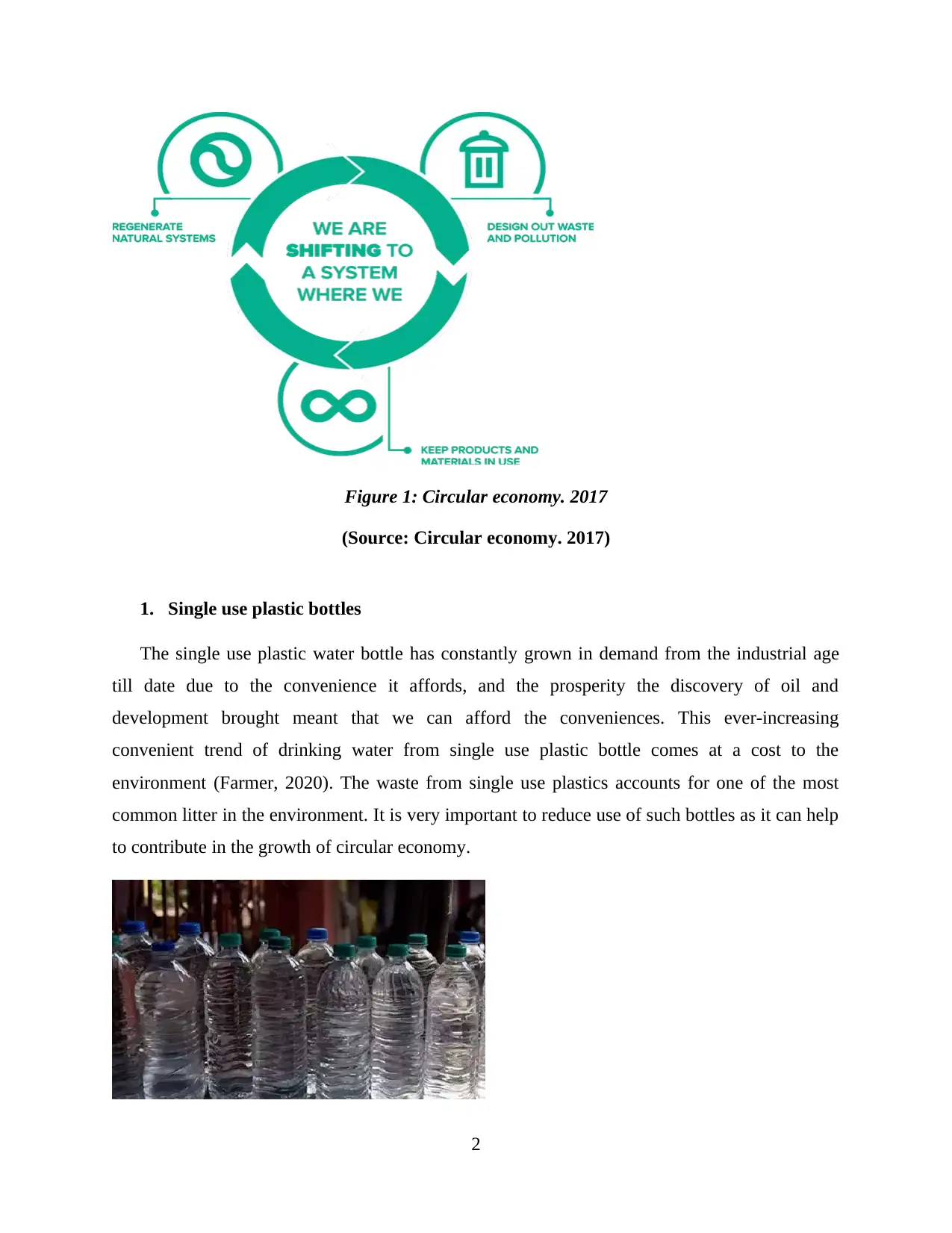
Figure 1: Circular economy. 2017
(Source: Circular economy. 2017)
1. Single use plastic bottles
The single use plastic water bottle has constantly grown in demand from the industrial age
till date due to the convenience it affords, and the prosperity the discovery of oil and
development brought meant that we can afford the conveniences. This ever-increasing
convenient trend of drinking water from single use plastic bottle comes at a cost to the
environment (Farmer, 2020). The waste from single use plastics accounts for one of the most
common litter in the environment. It is very important to reduce use of such bottles as it can help
to contribute in the growth of circular economy.
2
(Source: Circular economy. 2017)
1. Single use plastic bottles
The single use plastic water bottle has constantly grown in demand from the industrial age
till date due to the convenience it affords, and the prosperity the discovery of oil and
development brought meant that we can afford the conveniences. This ever-increasing
convenient trend of drinking water from single use plastic bottle comes at a cost to the
environment (Farmer, 2020). The waste from single use plastics accounts for one of the most
common litter in the environment. It is very important to reduce use of such bottles as it can help
to contribute in the growth of circular economy.
2
Secure Best Marks with AI Grader
Need help grading? Try our AI Grader for instant feedback on your assignments.
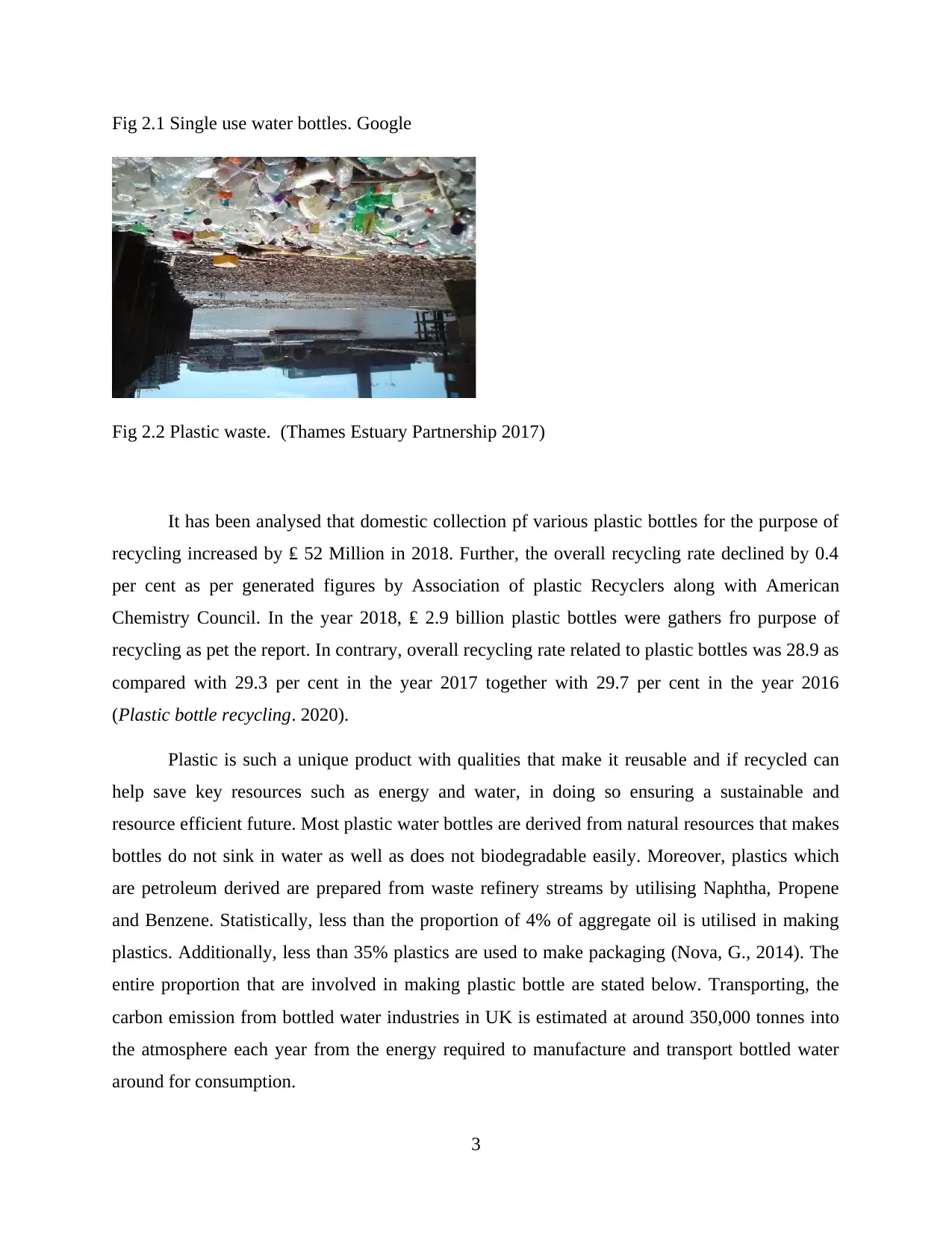
Fig 2.1 Single use water bottles. Google
Fig 2.2 Plastic waste. (Thames Estuary Partnership 2017)
It has been analysed that domestic collection pf various plastic bottles for the purpose of
recycling increased by ₤ 52 Million in 2018. Further, the overall recycling rate declined by 0.4
per cent as per generated figures by Association of plastic Recyclers along with American
Chemistry Council. In the year 2018, ₤ 2.9 billion plastic bottles were gathers fro purpose of
recycling as pet the report. In contrary, overall recycling rate related to plastic bottles was 28.9 as
compared with 29.3 per cent in the year 2017 together with 29.7 per cent in the year 2016
(Plastic bottle recycling. 2020).
Plastic is such a unique product with qualities that make it reusable and if recycled can
help save key resources such as energy and water, in doing so ensuring a sustainable and
resource efficient future. Most plastic water bottles are derived from natural resources that makes
bottles do not sink in water as well as does not biodegradable easily. Moreover, plastics which
are petroleum derived are prepared from waste refinery streams by utilising Naphtha, Propene
and Benzene. Statistically, less than the proportion of 4% of aggregate oil is utilised in making
plastics. Additionally, less than 35% plastics are used to make packaging (Nova, G., 2014). The
entire proportion that are involved in making plastic bottle are stated below. Transporting, the
carbon emission from bottled water industries in UK is estimated at around 350,000 tonnes into
the atmosphere each year from the energy required to manufacture and transport bottled water
around for consumption.
3
Fig 2.2 Plastic waste. (Thames Estuary Partnership 2017)
It has been analysed that domestic collection pf various plastic bottles for the purpose of
recycling increased by ₤ 52 Million in 2018. Further, the overall recycling rate declined by 0.4
per cent as per generated figures by Association of plastic Recyclers along with American
Chemistry Council. In the year 2018, ₤ 2.9 billion plastic bottles were gathers fro purpose of
recycling as pet the report. In contrary, overall recycling rate related to plastic bottles was 28.9 as
compared with 29.3 per cent in the year 2017 together with 29.7 per cent in the year 2016
(Plastic bottle recycling. 2020).
Plastic is such a unique product with qualities that make it reusable and if recycled can
help save key resources such as energy and water, in doing so ensuring a sustainable and
resource efficient future. Most plastic water bottles are derived from natural resources that makes
bottles do not sink in water as well as does not biodegradable easily. Moreover, plastics which
are petroleum derived are prepared from waste refinery streams by utilising Naphtha, Propene
and Benzene. Statistically, less than the proportion of 4% of aggregate oil is utilised in making
plastics. Additionally, less than 35% plastics are used to make packaging (Nova, G., 2014). The
entire proportion that are involved in making plastic bottle are stated below. Transporting, the
carbon emission from bottled water industries in UK is estimated at around 350,000 tonnes into
the atmosphere each year from the energy required to manufacture and transport bottled water
around for consumption.
3

Waste from single use plastic bottles poses a threat to the environment, despite most of it
being recyclable it is estimated that yearly, 5.5 billion plastic bottles end up in landfills or get
incinerated either ways. This is bad for the environment, survey carried out by Eunomia
Research and consulting estimates that approximately 233,00 tonnes of CO2 emission is
produced yearly from the effect of plastics in landfills due to time of decomposition
(Geissdoerfer and Et. At., 2018).
Table 1, Plastic products and recyclability WRAP (2009)
Code Plastic ABV Recyclable
#1 Polyethylene terephthalate PET Used for most single use
bottles
Yes
#2 High-density polyethylene HDPE Durable more solid Yes, depends
#3 Polyvinyl chloride PVC Not suitable or reusable
drinking bottles
NO
#4 Low-density polyethylene LDPE Durable more solid Yes, depends
#5 Polypropylene PP Used in recyclables Yes, depends
#6 Polystyrene PS Not suitable or reusable
drinking bottles
NO
#7 Polycarbonate PC Not suitable or reusable
drinking bottles
No
As per the report, PET and HDPE bottles makes around 97.1 percent of U.S. market for
plastic bottles. Addition to this, PP (Polypropylene) involves 1.8 percent, LDPE (Low density
4
being recyclable it is estimated that yearly, 5.5 billion plastic bottles end up in landfills or get
incinerated either ways. This is bad for the environment, survey carried out by Eunomia
Research and consulting estimates that approximately 233,00 tonnes of CO2 emission is
produced yearly from the effect of plastics in landfills due to time of decomposition
(Geissdoerfer and Et. At., 2018).
Table 1, Plastic products and recyclability WRAP (2009)
Code Plastic ABV Recyclable
#1 Polyethylene terephthalate PET Used for most single use
bottles
Yes
#2 High-density polyethylene HDPE Durable more solid Yes, depends
#3 Polyvinyl chloride PVC Not suitable or reusable
drinking bottles
NO
#4 Low-density polyethylene LDPE Durable more solid Yes, depends
#5 Polypropylene PP Used in recyclables Yes, depends
#6 Polystyrene PS Not suitable or reusable
drinking bottles
NO
#7 Polycarbonate PC Not suitable or reusable
drinking bottles
No
As per the report, PET and HDPE bottles makes around 97.1 percent of U.S. market for
plastic bottles. Addition to this, PP (Polypropylene) involves 1.8 percent, LDPE (Low density
4
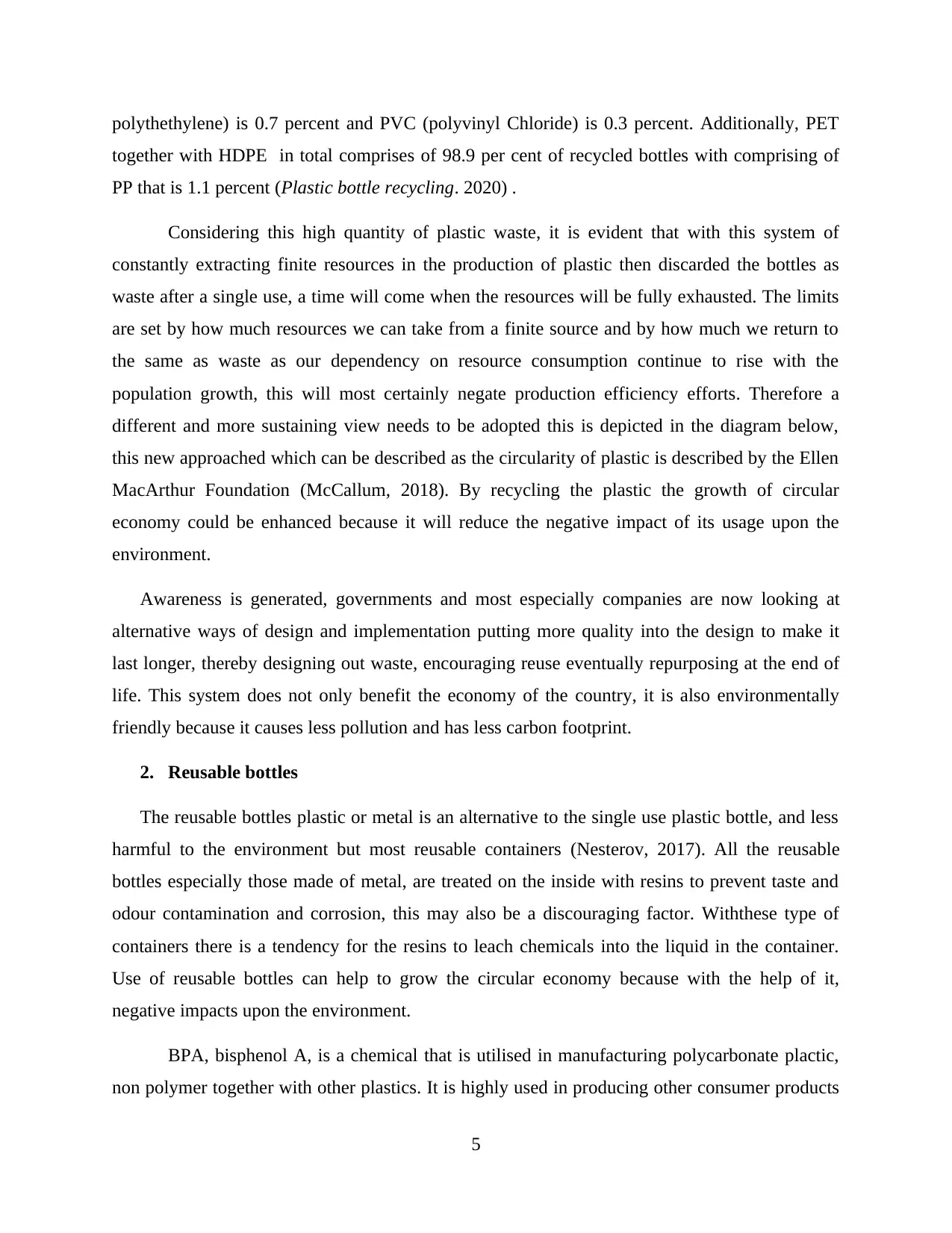
polythethylene) is 0.7 percent and PVC (polyvinyl Chloride) is 0.3 percent. Additionally, PET
together with HDPE in total comprises of 98.9 per cent of recycled bottles with comprising of
PP that is 1.1 percent (Plastic bottle recycling. 2020) .
Considering this high quantity of plastic waste, it is evident that with this system of
constantly extracting finite resources in the production of plastic then discarded the bottles as
waste after a single use, a time will come when the resources will be fully exhausted. The limits
are set by how much resources we can take from a finite source and by how much we return to
the same as waste as our dependency on resource consumption continue to rise with the
population growth, this will most certainly negate production efficiency efforts. Therefore a
different and more sustaining view needs to be adopted this is depicted in the diagram below,
this new approached which can be described as the circularity of plastic is described by the Ellen
MacArthur Foundation (McCallum, 2018). By recycling the plastic the growth of circular
economy could be enhanced because it will reduce the negative impact of its usage upon the
environment.
Awareness is generated, governments and most especially companies are now looking at
alternative ways of design and implementation putting more quality into the design to make it
last longer, thereby designing out waste, encouraging reuse eventually repurposing at the end of
life. This system does not only benefit the economy of the country, it is also environmentally
friendly because it causes less pollution and has less carbon footprint.
2. Reusable bottles
The reusable bottles plastic or metal is an alternative to the single use plastic bottle, and less
harmful to the environment but most reusable containers (Nesterov, 2017). All the reusable
bottles especially those made of metal, are treated on the inside with resins to prevent taste and
odour contamination and corrosion, this may also be a discouraging factor. Withthese type of
containers there is a tendency for the resins to leach chemicals into the liquid in the container.
Use of reusable bottles can help to grow the circular economy because with the help of it,
negative impacts upon the environment.
BPA, bisphenol A, is a chemical that is utilised in manufacturing polycarbonate plactic,
non polymer together with other plastics. It is highly used in producing other consumer products
5
together with HDPE in total comprises of 98.9 per cent of recycled bottles with comprising of
PP that is 1.1 percent (Plastic bottle recycling. 2020) .
Considering this high quantity of plastic waste, it is evident that with this system of
constantly extracting finite resources in the production of plastic then discarded the bottles as
waste after a single use, a time will come when the resources will be fully exhausted. The limits
are set by how much resources we can take from a finite source and by how much we return to
the same as waste as our dependency on resource consumption continue to rise with the
population growth, this will most certainly negate production efficiency efforts. Therefore a
different and more sustaining view needs to be adopted this is depicted in the diagram below,
this new approached which can be described as the circularity of plastic is described by the Ellen
MacArthur Foundation (McCallum, 2018). By recycling the plastic the growth of circular
economy could be enhanced because it will reduce the negative impact of its usage upon the
environment.
Awareness is generated, governments and most especially companies are now looking at
alternative ways of design and implementation putting more quality into the design to make it
last longer, thereby designing out waste, encouraging reuse eventually repurposing at the end of
life. This system does not only benefit the economy of the country, it is also environmentally
friendly because it causes less pollution and has less carbon footprint.
2. Reusable bottles
The reusable bottles plastic or metal is an alternative to the single use plastic bottle, and less
harmful to the environment but most reusable containers (Nesterov, 2017). All the reusable
bottles especially those made of metal, are treated on the inside with resins to prevent taste and
odour contamination and corrosion, this may also be a discouraging factor. Withthese type of
containers there is a tendency for the resins to leach chemicals into the liquid in the container.
Use of reusable bottles can help to grow the circular economy because with the help of it,
negative impacts upon the environment.
BPA, bisphenol A, is a chemical that is utilised in manufacturing polycarbonate plactic,
non polymer together with other plastics. It is highly used in producing other consumer products
5
Paraphrase This Document
Need a fresh take? Get an instant paraphrase of this document with our AI Paraphraser
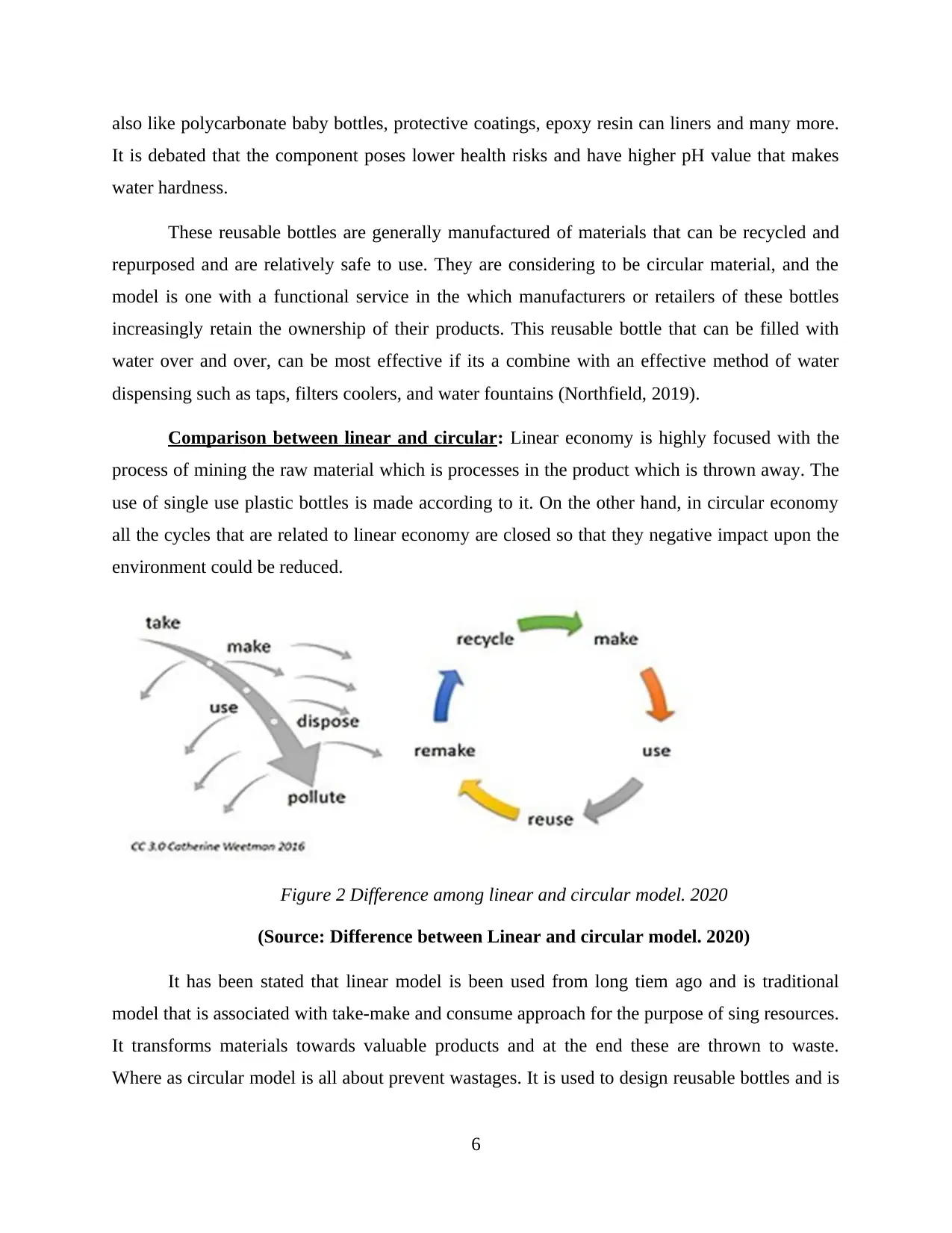
also like polycarbonate baby bottles, protective coatings, epoxy resin can liners and many more.
It is debated that the component poses lower health risks and have higher pH value that makes
water hardness.
These reusable bottles are generally manufactured of materials that can be recycled and
repurposed and are relatively safe to use. They are considering to be circular material, and the
model is one with a functional service in the which manufacturers or retailers of these bottles
increasingly retain the ownership of their products. This reusable bottle that can be filled with
water over and over, can be most effective if its a combine with an effective method of water
dispensing such as taps, filters coolers, and water fountains (Northfield, 2019).
Comparison between linear and circular: Linear economy is highly focused with the
process of mining the raw material which is processes in the product which is thrown away. The
use of single use plastic bottles is made according to it. On the other hand, in circular economy
all the cycles that are related to linear economy are closed so that they negative impact upon the
environment could be reduced.
Figure 2 Difference among linear and circular model. 2020
(Source: Difference between Linear and circular model. 2020)
It has been stated that linear model is been used from long tiem ago and is traditional
model that is associated with take-make and consume approach for the purpose of sing resources.
It transforms materials towards valuable products and at the end these are thrown to waste.
Where as circular model is all about prevent wastages. It is used to design reusable bottles and is
6
It is debated that the component poses lower health risks and have higher pH value that makes
water hardness.
These reusable bottles are generally manufactured of materials that can be recycled and
repurposed and are relatively safe to use. They are considering to be circular material, and the
model is one with a functional service in the which manufacturers or retailers of these bottles
increasingly retain the ownership of their products. This reusable bottle that can be filled with
water over and over, can be most effective if its a combine with an effective method of water
dispensing such as taps, filters coolers, and water fountains (Northfield, 2019).
Comparison between linear and circular: Linear economy is highly focused with the
process of mining the raw material which is processes in the product which is thrown away. The
use of single use plastic bottles is made according to it. On the other hand, in circular economy
all the cycles that are related to linear economy are closed so that they negative impact upon the
environment could be reduced.
Figure 2 Difference among linear and circular model. 2020
(Source: Difference between Linear and circular model. 2020)
It has been stated that linear model is been used from long tiem ago and is traditional
model that is associated with take-make and consume approach for the purpose of sing resources.
It transforms materials towards valuable products and at the end these are thrown to waste.
Where as circular model is all about prevent wastages. It is used to design reusable bottles and is
6
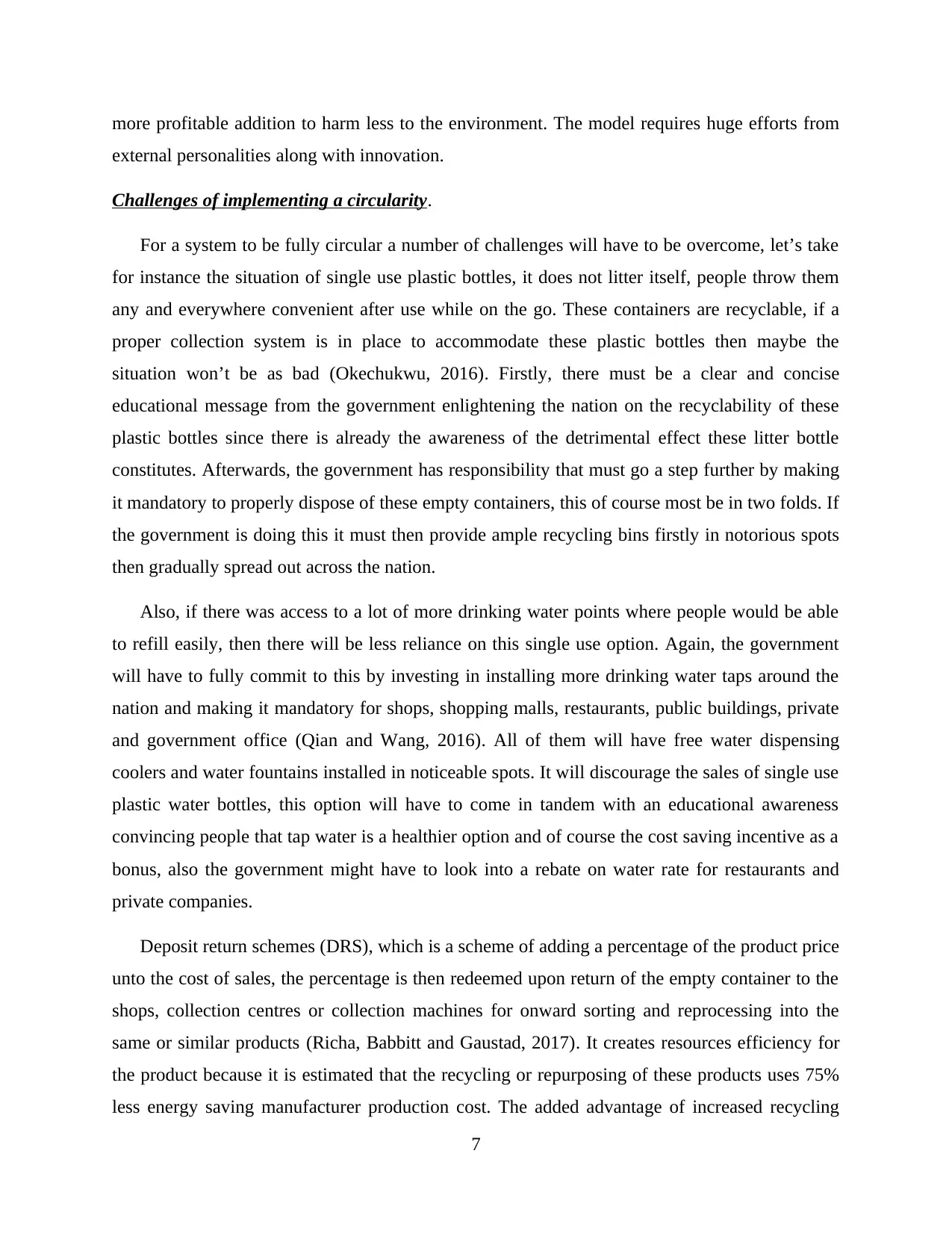
more profitable addition to harm less to the environment. The model requires huge efforts from
external personalities along with innovation.
Challenges of implementing a circularity.
For a system to be fully circular a number of challenges will have to be overcome, let’s take
for instance the situation of single use plastic bottles, it does not litter itself, people throw them
any and everywhere convenient after use while on the go. These containers are recyclable, if a
proper collection system is in place to accommodate these plastic bottles then maybe the
situation won’t be as bad (Okechukwu, 2016). Firstly, there must be a clear and concise
educational message from the government enlightening the nation on the recyclability of these
plastic bottles since there is already the awareness of the detrimental effect these litter bottle
constitutes. Afterwards, the government has responsibility that must go a step further by making
it mandatory to properly dispose of these empty containers, this of course most be in two folds. If
the government is doing this it must then provide ample recycling bins firstly in notorious spots
then gradually spread out across the nation.
Also, if there was access to a lot of more drinking water points where people would be able
to refill easily, then there will be less reliance on this single use option. Again, the government
will have to fully commit to this by investing in installing more drinking water taps around the
nation and making it mandatory for shops, shopping malls, restaurants, public buildings, private
and government office (Qian and Wang, 2016). All of them will have free water dispensing
coolers and water fountains installed in noticeable spots. It will discourage the sales of single use
plastic water bottles, this option will have to come in tandem with an educational awareness
convincing people that tap water is a healthier option and of course the cost saving incentive as a
bonus, also the government might have to look into a rebate on water rate for restaurants and
private companies.
Deposit return schemes (DRS), which is a scheme of adding a percentage of the product price
unto the cost of sales, the percentage is then redeemed upon return of the empty container to the
shops, collection centres or collection machines for onward sorting and reprocessing into the
same or similar products (Richa, Babbitt and Gaustad, 2017). It creates resources efficiency for
the product because it is estimated that the recycling or repurposing of these products uses 75%
less energy saving manufacturer production cost. The added advantage of increased recycling
7
external personalities along with innovation.
Challenges of implementing a circularity.
For a system to be fully circular a number of challenges will have to be overcome, let’s take
for instance the situation of single use plastic bottles, it does not litter itself, people throw them
any and everywhere convenient after use while on the go. These containers are recyclable, if a
proper collection system is in place to accommodate these plastic bottles then maybe the
situation won’t be as bad (Okechukwu, 2016). Firstly, there must be a clear and concise
educational message from the government enlightening the nation on the recyclability of these
plastic bottles since there is already the awareness of the detrimental effect these litter bottle
constitutes. Afterwards, the government has responsibility that must go a step further by making
it mandatory to properly dispose of these empty containers, this of course most be in two folds. If
the government is doing this it must then provide ample recycling bins firstly in notorious spots
then gradually spread out across the nation.
Also, if there was access to a lot of more drinking water points where people would be able
to refill easily, then there will be less reliance on this single use option. Again, the government
will have to fully commit to this by investing in installing more drinking water taps around the
nation and making it mandatory for shops, shopping malls, restaurants, public buildings, private
and government office (Qian and Wang, 2016). All of them will have free water dispensing
coolers and water fountains installed in noticeable spots. It will discourage the sales of single use
plastic water bottles, this option will have to come in tandem with an educational awareness
convincing people that tap water is a healthier option and of course the cost saving incentive as a
bonus, also the government might have to look into a rebate on water rate for restaurants and
private companies.
Deposit return schemes (DRS), which is a scheme of adding a percentage of the product price
unto the cost of sales, the percentage is then redeemed upon return of the empty container to the
shops, collection centres or collection machines for onward sorting and reprocessing into the
same or similar products (Richa, Babbitt and Gaustad, 2017). It creates resources efficiency for
the product because it is estimated that the recycling or repurposing of these products uses 75%
less energy saving manufacturer production cost. The added advantage of increased recycling
7
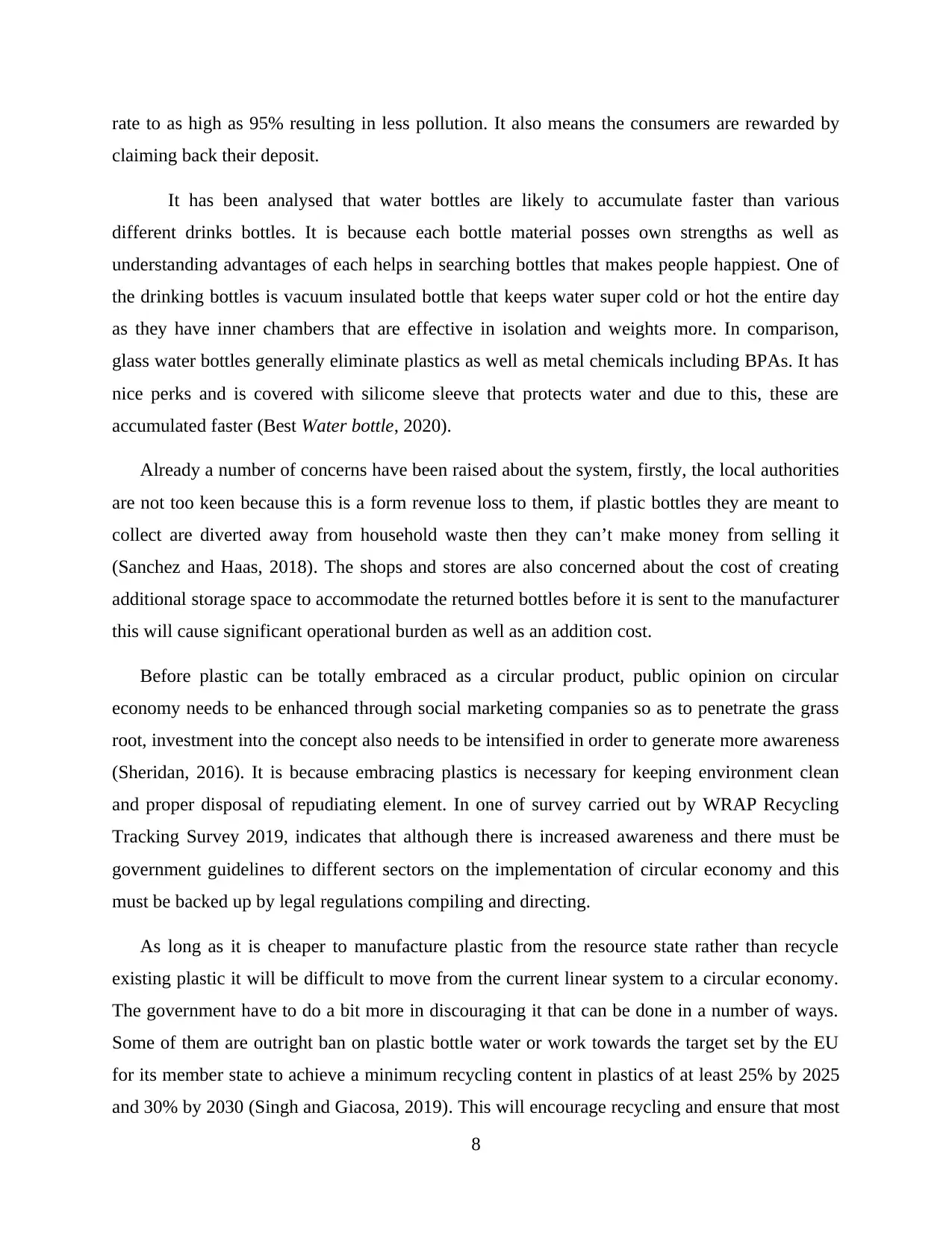
rate to as high as 95% resulting in less pollution. It also means the consumers are rewarded by
claiming back their deposit.
It has been analysed that water bottles are likely to accumulate faster than various
different drinks bottles. It is because each bottle material posses own strengths as well as
understanding advantages of each helps in searching bottles that makes people happiest. One of
the drinking bottles is vacuum insulated bottle that keeps water super cold or hot the entire day
as they have inner chambers that are effective in isolation and weights more. In comparison,
glass water bottles generally eliminate plastics as well as metal chemicals including BPAs. It has
nice perks and is covered with silicome sleeve that protects water and due to this, these are
accumulated faster (Best Water bottle, 2020).
Already a number of concerns have been raised about the system, firstly, the local authorities
are not too keen because this is a form revenue loss to them, if plastic bottles they are meant to
collect are diverted away from household waste then they can’t make money from selling it
(Sanchez and Haas, 2018). The shops and stores are also concerned about the cost of creating
additional storage space to accommodate the returned bottles before it is sent to the manufacturer
this will cause significant operational burden as well as an addition cost.
Before plastic can be totally embraced as a circular product, public opinion on circular
economy needs to be enhanced through social marketing companies so as to penetrate the grass
root, investment into the concept also needs to be intensified in order to generate more awareness
(Sheridan, 2016). It is because embracing plastics is necessary for keeping environment clean
and proper disposal of repudiating element. In one of survey carried out by WRAP Recycling
Tracking Survey 2019, indicates that although there is increased awareness and there must be
government guidelines to different sectors on the implementation of circular economy and this
must be backed up by legal regulations compiling and directing.
As long as it is cheaper to manufacture plastic from the resource state rather than recycle
existing plastic it will be difficult to move from the current linear system to a circular economy.
The government have to do a bit more in discouraging it that can be done in a number of ways.
Some of them are outright ban on plastic bottle water or work towards the target set by the EU
for its member state to achieve a minimum recycling content in plastics of at least 25% by 2025
and 30% by 2030 (Singh and Giacosa, 2019). This will encourage recycling and ensure that most
8
claiming back their deposit.
It has been analysed that water bottles are likely to accumulate faster than various
different drinks bottles. It is because each bottle material posses own strengths as well as
understanding advantages of each helps in searching bottles that makes people happiest. One of
the drinking bottles is vacuum insulated bottle that keeps water super cold or hot the entire day
as they have inner chambers that are effective in isolation and weights more. In comparison,
glass water bottles generally eliminate plastics as well as metal chemicals including BPAs. It has
nice perks and is covered with silicome sleeve that protects water and due to this, these are
accumulated faster (Best Water bottle, 2020).
Already a number of concerns have been raised about the system, firstly, the local authorities
are not too keen because this is a form revenue loss to them, if plastic bottles they are meant to
collect are diverted away from household waste then they can’t make money from selling it
(Sanchez and Haas, 2018). The shops and stores are also concerned about the cost of creating
additional storage space to accommodate the returned bottles before it is sent to the manufacturer
this will cause significant operational burden as well as an addition cost.
Before plastic can be totally embraced as a circular product, public opinion on circular
economy needs to be enhanced through social marketing companies so as to penetrate the grass
root, investment into the concept also needs to be intensified in order to generate more awareness
(Sheridan, 2016). It is because embracing plastics is necessary for keeping environment clean
and proper disposal of repudiating element. In one of survey carried out by WRAP Recycling
Tracking Survey 2019, indicates that although there is increased awareness and there must be
government guidelines to different sectors on the implementation of circular economy and this
must be backed up by legal regulations compiling and directing.
As long as it is cheaper to manufacture plastic from the resource state rather than recycle
existing plastic it will be difficult to move from the current linear system to a circular economy.
The government have to do a bit more in discouraging it that can be done in a number of ways.
Some of them are outright ban on plastic bottle water or work towards the target set by the EU
for its member state to achieve a minimum recycling content in plastics of at least 25% by 2025
and 30% by 2030 (Singh and Giacosa, 2019). This will encourage recycling and ensure that most
8
Secure Best Marks with AI Grader
Need help grading? Try our AI Grader for instant feedback on your assignments.
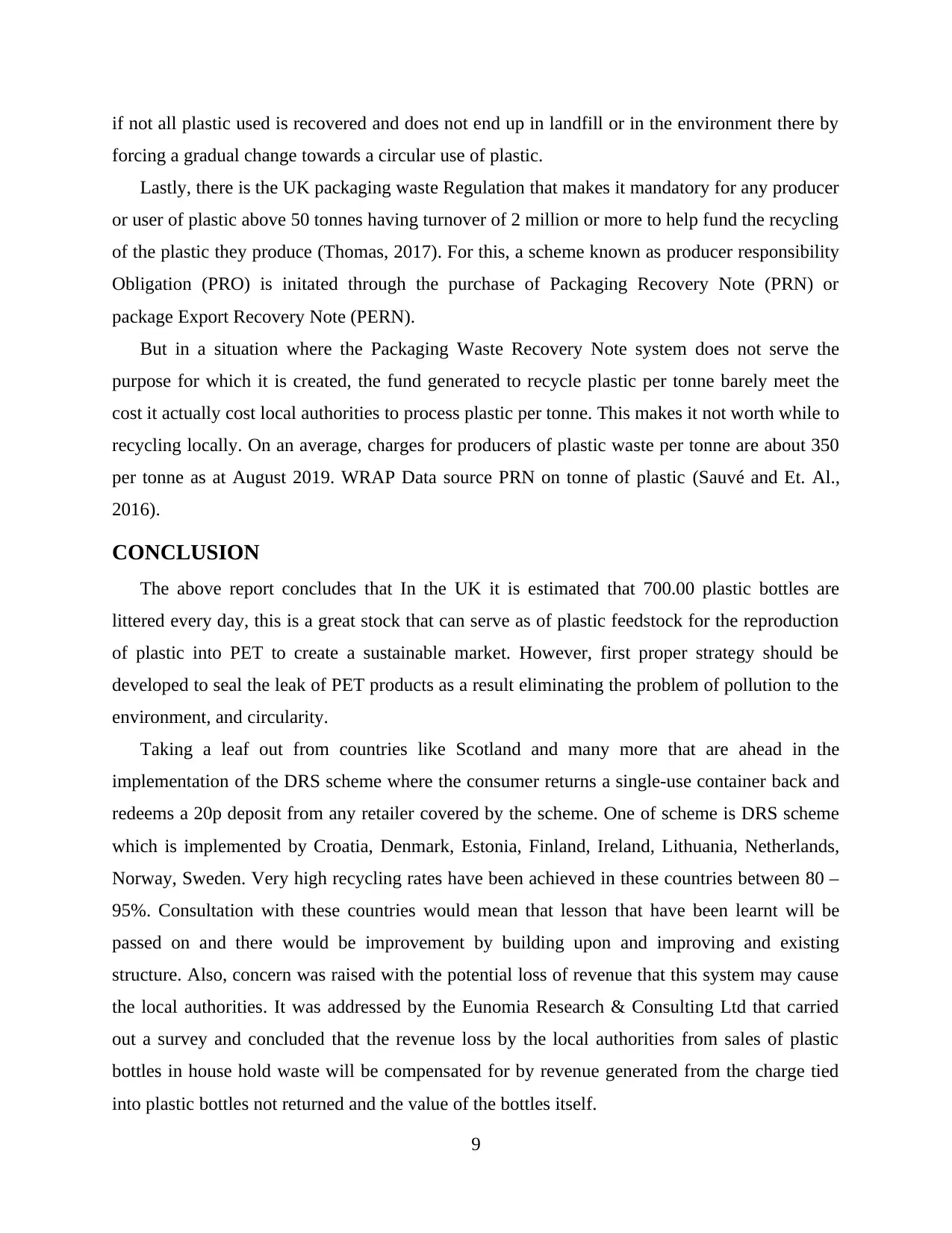
if not all plastic used is recovered and does not end up in landfill or in the environment there by
forcing a gradual change towards a circular use of plastic.
Lastly, there is the UK packaging waste Regulation that makes it mandatory for any producer
or user of plastic above 50 tonnes having turnover of 2 million or more to help fund the recycling
of the plastic they produce (Thomas, 2017). For this, a scheme known as producer responsibility
Obligation (PRO) is initated through the purchase of Packaging Recovery Note (PRN) or
package Export Recovery Note (PERN).
But in a situation where the Packaging Waste Recovery Note system does not serve the
purpose for which it is created, the fund generated to recycle plastic per tonne barely meet the
cost it actually cost local authorities to process plastic per tonne. This makes it not worth while to
recycling locally. On an average, charges for producers of plastic waste per tonne are about 350
per tonne as at August 2019. WRAP Data source PRN on tonne of plastic (Sauvé and Et. Al.,
2016).
CONCLUSION
The above report concludes that In the UK it is estimated that 700.00 plastic bottles are
littered every day, this is a great stock that can serve as of plastic feedstock for the reproduction
of plastic into PET to create a sustainable market. However, first proper strategy should be
developed to seal the leak of PET products as a result eliminating the problem of pollution to the
environment, and circularity.
Taking a leaf out from countries like Scotland and many more that are ahead in the
implementation of the DRS scheme where the consumer returns a single-use container back and
redeems a 20p deposit from any retailer covered by the scheme. One of scheme is DRS scheme
which is implemented by Croatia, Denmark, Estonia, Finland, Ireland, Lithuania, Netherlands,
Norway, Sweden. Very high recycling rates have been achieved in these countries between 80 –
95%. Consultation with these countries would mean that lesson that have been learnt will be
passed on and there would be improvement by building upon and improving and existing
structure. Also, concern was raised with the potential loss of revenue that this system may cause
the local authorities. It was addressed by the Eunomia Research & Consulting Ltd that carried
out a survey and concluded that the revenue loss by the local authorities from sales of plastic
bottles in house hold waste will be compensated for by revenue generated from the charge tied
into plastic bottles not returned and the value of the bottles itself.
9
forcing a gradual change towards a circular use of plastic.
Lastly, there is the UK packaging waste Regulation that makes it mandatory for any producer
or user of plastic above 50 tonnes having turnover of 2 million or more to help fund the recycling
of the plastic they produce (Thomas, 2017). For this, a scheme known as producer responsibility
Obligation (PRO) is initated through the purchase of Packaging Recovery Note (PRN) or
package Export Recovery Note (PERN).
But in a situation where the Packaging Waste Recovery Note system does not serve the
purpose for which it is created, the fund generated to recycle plastic per tonne barely meet the
cost it actually cost local authorities to process plastic per tonne. This makes it not worth while to
recycling locally. On an average, charges for producers of plastic waste per tonne are about 350
per tonne as at August 2019. WRAP Data source PRN on tonne of plastic (Sauvé and Et. Al.,
2016).
CONCLUSION
The above report concludes that In the UK it is estimated that 700.00 plastic bottles are
littered every day, this is a great stock that can serve as of plastic feedstock for the reproduction
of plastic into PET to create a sustainable market. However, first proper strategy should be
developed to seal the leak of PET products as a result eliminating the problem of pollution to the
environment, and circularity.
Taking a leaf out from countries like Scotland and many more that are ahead in the
implementation of the DRS scheme where the consumer returns a single-use container back and
redeems a 20p deposit from any retailer covered by the scheme. One of scheme is DRS scheme
which is implemented by Croatia, Denmark, Estonia, Finland, Ireland, Lithuania, Netherlands,
Norway, Sweden. Very high recycling rates have been achieved in these countries between 80 –
95%. Consultation with these countries would mean that lesson that have been learnt will be
passed on and there would be improvement by building upon and improving and existing
structure. Also, concern was raised with the potential loss of revenue that this system may cause
the local authorities. It was addressed by the Eunomia Research & Consulting Ltd that carried
out a survey and concluded that the revenue loss by the local authorities from sales of plastic
bottles in house hold waste will be compensated for by revenue generated from the charge tied
into plastic bottles not returned and the value of the bottles itself.
9
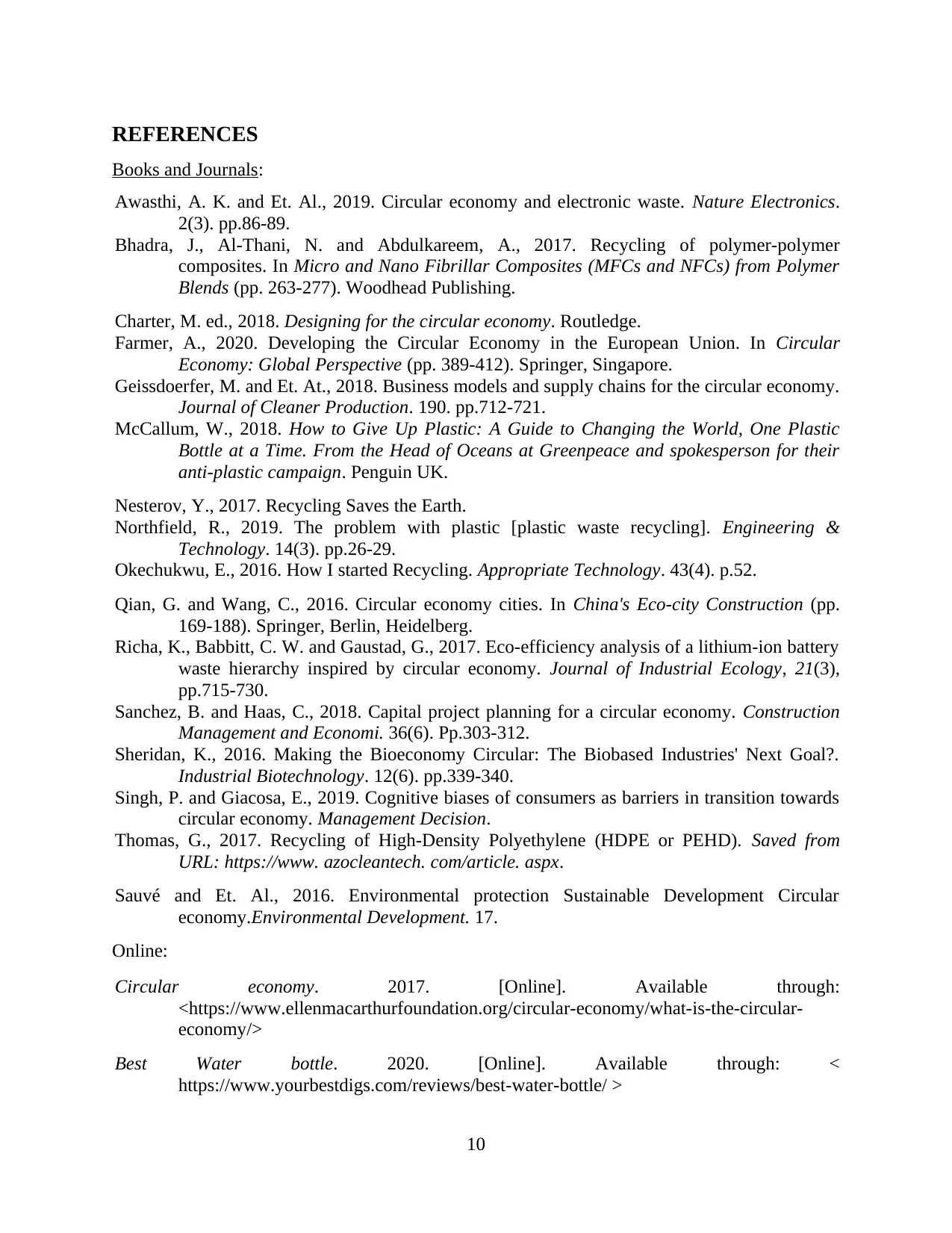
REFERENCES
Books and Journals:
Awasthi, A. K. and Et. Al., 2019. Circular economy and electronic waste. Nature Electronics.
2(3). pp.86-89.
Bhadra, J., Al-Thani, N. and Abdulkareem, A., 2017. Recycling of polymer-polymer
composites. In Micro and Nano Fibrillar Composites (MFCs and NFCs) from Polymer
Blends (pp. 263-277). Woodhead Publishing.
Charter, M. ed., 2018. Designing for the circular economy. Routledge.
Farmer, A., 2020. Developing the Circular Economy in the European Union. In Circular
Economy: Global Perspective (pp. 389-412). Springer, Singapore.
Geissdoerfer, M. and Et. At., 2018. Business models and supply chains for the circular economy.
Journal of Cleaner Production. 190. pp.712-721.
McCallum, W., 2018. How to Give Up Plastic: A Guide to Changing the World, One Plastic
Bottle at a Time. From the Head of Oceans at Greenpeace and spokesperson for their
anti-plastic campaign. Penguin UK.
Nesterov, Y., 2017. Recycling Saves the Earth.
Northfield, R., 2019. The problem with plastic [plastic waste recycling]. Engineering &
Technology. 14(3). pp.26-29.
Okechukwu, E., 2016. How I started Recycling. Appropriate Technology. 43(4). p.52.
Qian, G. and Wang, C., 2016. Circular economy cities. In China's Eco-city Construction (pp.
169-188). Springer, Berlin, Heidelberg.
Richa, K., Babbitt, C. W. and Gaustad, G., 2017. Eco‐efficiency analysis of a lithium‐ion battery
waste hierarchy inspired by circular economy. Journal of Industrial Ecology, 21(3),
pp.715-730.
Sanchez, B. and Haas, C., 2018. Capital project planning for a circular economy. Construction
Management and Economi. 36(6). Pp.303-312.
Sheridan, K., 2016. Making the Bioeconomy Circular: The Biobased Industries' Next Goal?.
Industrial Biotechnology. 12(6). pp.339-340.
Singh, P. and Giacosa, E., 2019. Cognitive biases of consumers as barriers in transition towards
circular economy. Management Decision.
Thomas, G., 2017. Recycling of High-Density Polyethylene (HDPE or PEHD). Saved from
URL: https://www. azocleantech. com/article. aspx.
Sauvé and Et. Al., 2016. Environmental protection Sustainable Development Circular
economy.Environmental Development. 17.
Online:
Circular economy. 2017. [Online]. Available through:
<https://www.ellenmacarthurfoundation.org/circular-economy/what-is-the-circular-
economy/>
Best Water bottle. 2020. [Online]. Available through: <
https://www.yourbestdigs.com/reviews/best-water-bottle/ >
10
Books and Journals:
Awasthi, A. K. and Et. Al., 2019. Circular economy and electronic waste. Nature Electronics.
2(3). pp.86-89.
Bhadra, J., Al-Thani, N. and Abdulkareem, A., 2017. Recycling of polymer-polymer
composites. In Micro and Nano Fibrillar Composites (MFCs and NFCs) from Polymer
Blends (pp. 263-277). Woodhead Publishing.
Charter, M. ed., 2018. Designing for the circular economy. Routledge.
Farmer, A., 2020. Developing the Circular Economy in the European Union. In Circular
Economy: Global Perspective (pp. 389-412). Springer, Singapore.
Geissdoerfer, M. and Et. At., 2018. Business models and supply chains for the circular economy.
Journal of Cleaner Production. 190. pp.712-721.
McCallum, W., 2018. How to Give Up Plastic: A Guide to Changing the World, One Plastic
Bottle at a Time. From the Head of Oceans at Greenpeace and spokesperson for their
anti-plastic campaign. Penguin UK.
Nesterov, Y., 2017. Recycling Saves the Earth.
Northfield, R., 2019. The problem with plastic [plastic waste recycling]. Engineering &
Technology. 14(3). pp.26-29.
Okechukwu, E., 2016. How I started Recycling. Appropriate Technology. 43(4). p.52.
Qian, G. and Wang, C., 2016. Circular economy cities. In China's Eco-city Construction (pp.
169-188). Springer, Berlin, Heidelberg.
Richa, K., Babbitt, C. W. and Gaustad, G., 2017. Eco‐efficiency analysis of a lithium‐ion battery
waste hierarchy inspired by circular economy. Journal of Industrial Ecology, 21(3),
pp.715-730.
Sanchez, B. and Haas, C., 2018. Capital project planning for a circular economy. Construction
Management and Economi. 36(6). Pp.303-312.
Sheridan, K., 2016. Making the Bioeconomy Circular: The Biobased Industries' Next Goal?.
Industrial Biotechnology. 12(6). pp.339-340.
Singh, P. and Giacosa, E., 2019. Cognitive biases of consumers as barriers in transition towards
circular economy. Management Decision.
Thomas, G., 2017. Recycling of High-Density Polyethylene (HDPE or PEHD). Saved from
URL: https://www. azocleantech. com/article. aspx.
Sauvé and Et. Al., 2016. Environmental protection Sustainable Development Circular
economy.Environmental Development. 17.
Online:
Circular economy. 2017. [Online]. Available through:
<https://www.ellenmacarthurfoundation.org/circular-economy/what-is-the-circular-
economy/>
Best Water bottle. 2020. [Online]. Available through: <
https://www.yourbestdigs.com/reviews/best-water-bottle/ >
10
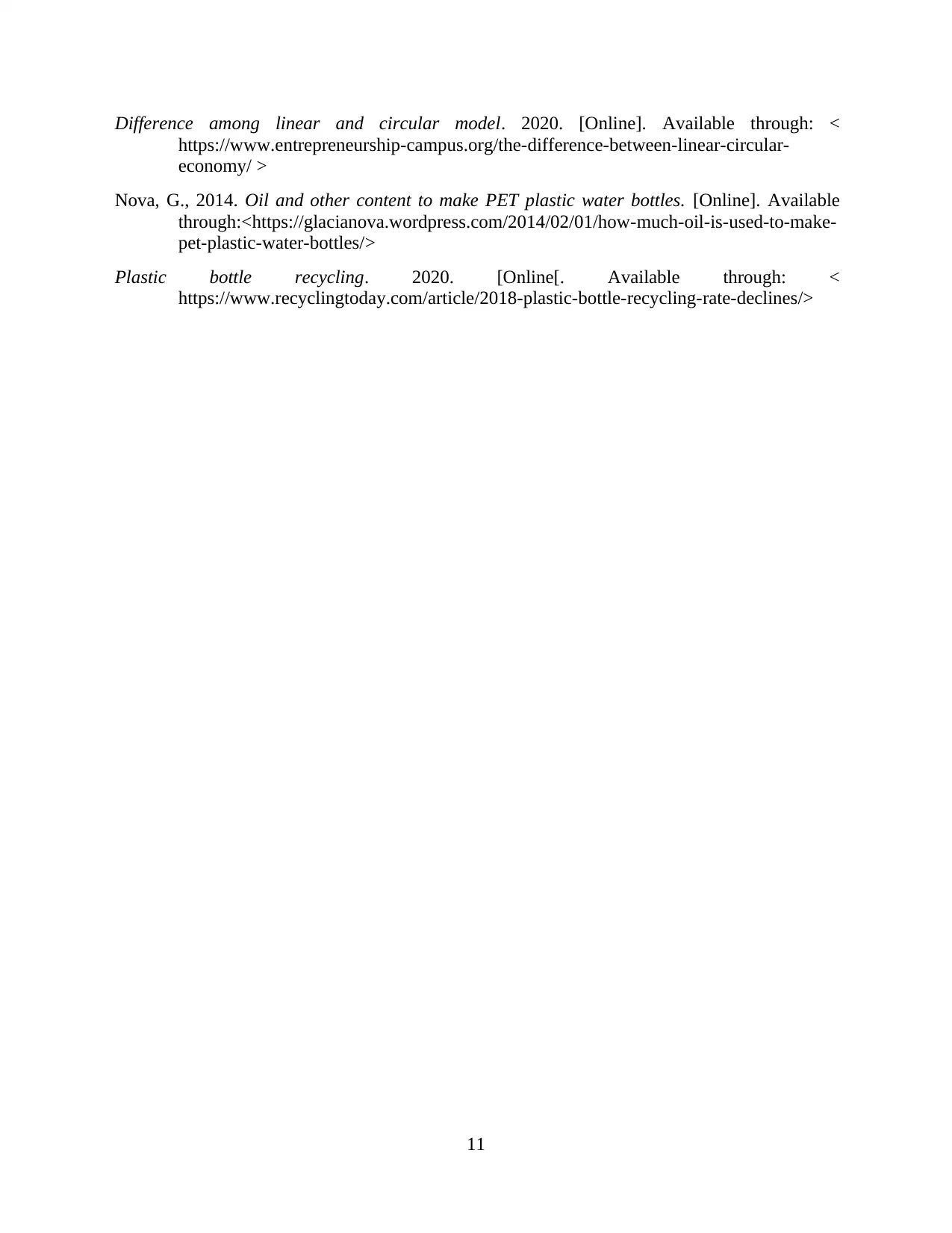
Difference among linear and circular model. 2020. [Online]. Available through: <
https://www.entrepreneurship-campus.org/the-difference-between-linear-circular-
economy/ >
Nova, G., 2014. Oil and other content to make PET plastic water bottles. [Online]. Available
through:<https://glacianova.wordpress.com/2014/02/01/how-much-oil-is-used-to-make-
pet-plastic-water-bottles/>
Plastic bottle recycling. 2020. [Online[. Available through: <
https://www.recyclingtoday.com/article/2018-plastic-bottle-recycling-rate-declines/>
11
https://www.entrepreneurship-campus.org/the-difference-between-linear-circular-
economy/ >
Nova, G., 2014. Oil and other content to make PET plastic water bottles. [Online]. Available
through:<https://glacianova.wordpress.com/2014/02/01/how-much-oil-is-used-to-make-
pet-plastic-water-bottles/>
Plastic bottle recycling. 2020. [Online[. Available through: <
https://www.recyclingtoday.com/article/2018-plastic-bottle-recycling-rate-declines/>
11
1 out of 13
Related Documents
Your All-in-One AI-Powered Toolkit for Academic Success.
+13062052269
info@desklib.com
Available 24*7 on WhatsApp / Email
![[object Object]](/_next/static/media/star-bottom.7253800d.svg)
Unlock your academic potential
© 2024 | Zucol Services PVT LTD | All rights reserved.





